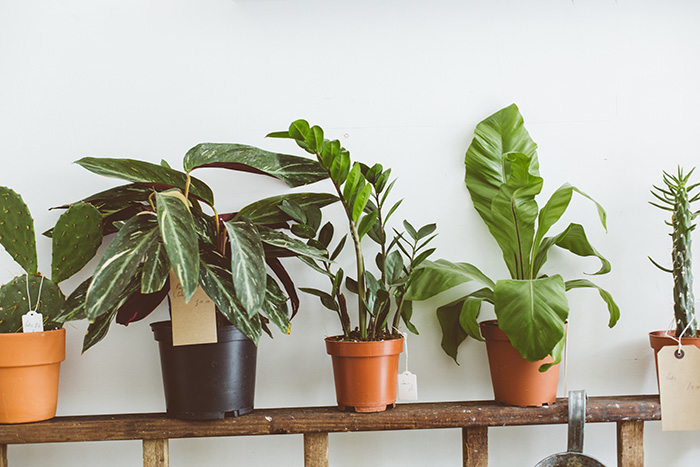Choosing houseplants for your home
© Anna Jacobsen
With a little knowledge, your dream of a stylish indoor garden, of plants that will thrive, can be created with ease
Consider first the type of light in the space you intend to position your plant. Although overwatering is the number one killer of houseplants, light level is by far the most important factor when choosing which plant to put where.
It’s important to remember that aspects will differ with each space, and even if you have a south-facing room there may be darker areas within it. With this is mind, spend time in your home monitoring how the light changes throughout the day, to get a clear picture of its levels and intensity.

© Anna Jacobsen
Full-sun aspects
This is south-facing, giving the plant direct sun on its leaves all day. Opt for succulents, cacti, pelargonium (these tend to have bright flowers and resemble geraniums) and oxalis (the purple Oxalis triangularis, or shamrock plant, is a popular choice). Little else will be able to tolerate such intense sun all day.
Full sun to partial shade
This position is either east, getting the morning sun and bright all day, or west-facing, with lower light in the morning and intense afternoon sun. It suits plants including tradescantia (wandering dude) and the closely related zebrina (elephant’s ear), sansevieria (snake plant), Ficus elastica (rubber plant), cordyline and codiaeum (croton). All but the sansevieria, though, should be shielded from intense midday and afternoon sun.

© Tamsyn Morgans
Bright light to partial shade
The most common houseplants love this position, generally north-facing, with moments of bright indirect sun followed by all-day shade. These include monstera (Swiss cheese plant), asparagus ferns, Begonia rex, spider plants, Pilea peperomioides (Chinese money plant), philodendron, schefflera (umbrella tree) and scindapsus (devil’s ivy).
Partial shade to shade
The lowest light suitable for houseplants, this position will still have a window but will only receive low natural light; a darker corner in a more well-lit room also qualifies. Choose dracaena, zamia (ZZ plant), sansevieria (snake plant), calathea (prayer plant), Boston ferns, aspidistra (cast-iron plant) and scindapsus (devil’s ivy).
For a deeper shade position, set away from a north-facing window, best bets are asplenium (bird’s nest fern), fittonia and Philodendron scandens (sweetheart plant). Also try positioning the plants suggested for partial shade in deeper shade, but variegated leaves will lose definition and plants that don’t fair well should be moved back to partial shade.

© Shutterstock
Temperature and atmosphere
Bear in mind the temperature of the room when choosing your plants. A humid space, such as a kitchen or bathroom, suits tropical plants including calathea or ferns (there are different varieties). Succulents and cacti thrive in drier air, as they’re used to arid conditions.
Draughts or fluctuations in heat will make your plants miserable, cause leaf loss or make the soil dry out more quickly or slower than is needed, so avoid placing them on or next to radiators or underfloor heating. Try to get the position right from the start; as a rule, plants do not like to be moved around too much.

© Anna Jacobsen
Tips on buying
Consider your lifestyle
How much time do you have to take care of houseplants? If you travel frequently, you may wish to opt for low-maintenance plants like cacti and succulents. If you work from home or are a serial overwaterer, consider plants that require regular nurturing.
Go prepared
A well-run plant shop or nursery will have staff that can advise on plants that will suit your space, but visit armed with knowledge of the light level in your home and where the plant will be positioned.
Check for health
Look for pests or discolouration on the leaves before making your purchase.
Keep the plant label
Always ask for the full name of the plant you are buying if it is not labelled, and for care tips. If you have the full name but the seller can’t give you care information, then you can always do your own research online.
WORDS: ANGELA MAYNARD
Before you go...
...fancy automatic entry to all future competitions?
Simply register online today for FREE and you will get:
Automatic entry to all current and future competitions.
Access to Reclaim Inspiration - an online visual pinboard for saving all your home and style inspiration.
A regular newsletter of inspiration, ideas and advice.

Save all your articles in one place
Become a Reclaim Member to save all your home and style inspiration. Simply login or register online today for FREE and you will get:
Automatic entry to all current and future competitions.
Access to Reclaim Inspiration - an online visual pinboard for saving all your home and style inspiration.
A regular newsletter of inspiration, ideas and advice.








